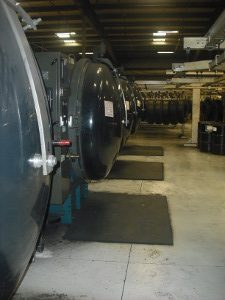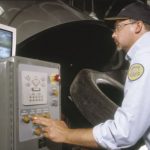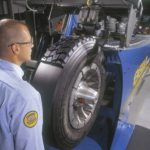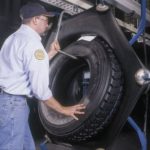Retread Process
 Retread Process at Pete’s Tire Barns
Retread Process at Pete’s Tire Barns
-
 Initial Inspection
Initial Inspection
- First, your casings are thoroughly inspected to ensure they meet our high retreading standards. Our inspectors look for every cut, bruise, and puncture, as well as other damage to the tire body. Repairs are made using strong, flexible Bandag repair materials.
-
 Casing Analyzer
Casing Analyzer
- A pre-buff inspection that reduces costs as non-retreadable casing are removed sooner. Provides a bead to bead scan with unmatched accuracy.
-
 The Bandag Non-Destructive Inspection
The Bandag Non-Destructive Inspection
- Ultrasonic inspection for damage hidden from visual inspection is performed, using the NDI Tire Casing Analyzer.
-
 Buffing
Buffing
- Buffing removes the old, worn tread design. The Bandag buffer works like a lathe as the tire is buffed, truing your inflated casing with utmost precision. That means a smoother running retread to satisfy your drivers and reduce vehicle maintenance.
-
 Repairs
Repairs
- Bandag repair materials are designed specifically for today’s new generation tires. All repair procedures are an integral part of the total Bandag process. Nail hole injuries, crown injuries, and sidewall injuries can be repaired routinely. You save more valuable casings.
-
 Building
Building
- Cushion gum (the adhesive layer) is applied to the back of the exclusive Bandag tread. Tread rubber and cushion are applied to the casing while the tire is inflated to its normal running configuration. Cushion gum bonds the tough Bandag tread rubber to your casing. This bond becomes one of the strongest parts of the tire. It’s what makes our Bandag retreads dependable.
-
 Curing
Curing
- Bandag bonds new tread rubber to your casing using a low curing temperature. Your tire is encased in a flexible rubber envelope and placed in a pressure chamber to prevent distortion. No excessive heat or rigid metal molds means your casings avoid the stress associated with other retreading processes.
-
 Final Inspection
Final Inspection
- Every Bandag retread we produce is thoroughly inspected before it leaves our shop. The last place we want to discover a tire problem is after the tire is back in service. We’re sure you would agree.
 Retread Process at Pete’s Tire Barns
Retread Process at Pete’s Tire Barns Initial Inspection
Initial Inspection Casing Analyzer
Casing Analyzer The Bandag Non-Destructive Inspection
The Bandag Non-Destructive Inspection Buffing
Buffing Repairs
Repairs Building
Building Curing
Curing Final Inspection
Final Inspection




